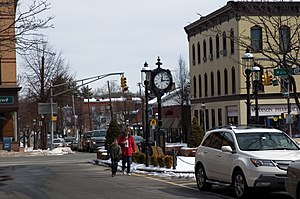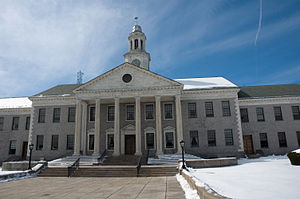Seach Madison Homes in $400,000-800,000
$800,000-1,200,000
$1,200,000-1,600,000
$1,600,000-2,000,000
Madison, New Jersey
| Madison, New Jersey | |
|---|---|
| borough | |
| Borough of Madison[1] | |
| Downtown Madison | |
| Nickname(s): The Rose City[2] | |
| Madison highlighted in Morris County Inset map: Morris County highlighted in the state of New Jersey | |
| Census Bureau map of Madison, New Jersey | |
| Coordinates: 40.7580°N 74.4178°WCoordinates: 40.7580°N 74.4178°W[3][4] | |
| Country | United States |
| State | New Jersey |
| County | Morris |
| Incorporated | December 27, 1889 |
| Government[8] | |
| • Type | Borough |
| • Mayor | Robert H. Conley (term ends December 31, 2015)[5] |
| • Administrator | Ray Codey[6] |
| • Clerk | Elizabeth Osborne[7] |
| Area[4] | |
| • Total | 4.218 sq mi (10.926 km2) |
| • Land | 4.205 sq mi (10.891 km2) |
| • Water | 0.013 sq mi (0.035 km2) 0.32% |
| Area rank | 291st of 566 in state 24th of 39 in county[4] |
| Elevation[9] | 266 ft (81 m) |
| Population (2010 Census)[10][11][12] | |
| • Total | 15,845 |
| • Estimate (2012[13]) | 16,128 |
| • Rank | 160th of 566 in state 13th of 39 in county[14] |
| • Density | 3,767.9/sq mi (1,454.8/km2) |
| • Density rank | 168th of 566 in state 6th of 39 in county[14] |
| Time zone | EST (UTC-5) |
| • Summer (DST) | Eastern (EDT) (UTC-4) |
| ZIP code | 07940[15][16] |
| Area code(s) | 862/973[17] |
| FIPS code | 3402742510[18][4][19] |
| GNIS feature ID | 0885287[20] |
| Website | www.rosenet.org/gov/ |
Madison is a borough in Morris County, New Jersey, in the United States. As of the 2010 United States Census, the population was 15,845,[10][11][12] reflecting a drop in population of 685 (−4.1%) from the 16,530 counted in the2000 Census, which had in turn increased by 680 (+4.3%) from the 15,850 counted in the1990 Census.[21] It is known as "The Rose City".[2]
Geography[edit]
Madison is located at 40°45′29″N 74°25′04″W(40.758044,-74.417807). According to the United States Census Bureau, the borough had a total area of 4.218 square miles (10.926 km2), of which, 4.2057 square miles (10.891 km2) of it is land and 0.013 square miles (0.035 km2) of it (0.32%) is water.[3][4] Madison is located about 25 miles (40 km) west of downtown Manhattan, and is a suburban town of New York City.[2]
Historical populations
Census
Pop.
%±
1890
2,469
—
1900
3,754
52.0%
1910
4,658
24.1%
1920
5,523
18.6%
1930
7,481
35.5%
1940
7,944
6.2%
1950
10,417
31.1%
1960
15,122
45.2%
1970
16,710
10.5%
1980
15,357
−8.1%
1990
15,850
3.2%
2000
16,530
4.3%
2010
15,845
−4.1%
Est. 2012
16,128
[13]
1.8%
Population sources: 1890-1920[23]
1890–1910[24] 1890–1930[25]
1930–1990[26] 2000[27][28] 2010[10][11][12]
Demographics[edit]
1890–1910[24] 1890–1930[25]
1930–1990[26] 2000[27][28] 2010[10][11][12]
Census 2010[edit]
At the 2010 United States Census, there were 15,845 people, 5,485 households, and 3,675 families residing in the borough. Thepopulation density was 3,767.9 inhabitants per square mile (1,454.8 /km2). There were 5,775 housing units at an average density of 1,373.3 per square mile (530.2 /km2). The racial makeup of the borough was 86.75% (13,746) White, 2.96% (469)Black or African American, 0.12% (19) Native American, 5.51% (873) Asian, 0.01% (2) Pacific Islander, 2.34% (371) from other races, and 2.30% (365) from two or more races. Hispanic orLatino of any race were 8.87% (1,406) of the population.[10]
There were 5,485 households of which 34.5% had children under the age of 18 living with them, 56.0% were married couples living together, 8.7% had a female householder with no husband present, and 33.0% were non-families. 27.2% of all households were made up of individuals and 11.4% had someone living alone who was 65 years of age or older. The average household size was 2.58 and the average family size was 3.19.[10]
In the borough, 23.7% of the population were under the age of 18, 13.6% from 18 to 24, 23.7% from 25 to 44, 24.7% from 45 to 64, and 14.2% who were 65 years of age or older. The median age was 38.0 years. For every 100 females there were 89.9 males. For every 100 females age 18 and over, there were 85.3 males.[10]
The Census Bureau's 2006–2010 American Community Survey showed that (in 2010 inflation-adjusted dollars) median household income was $106,070 (with a margin of error of +/- $8,499) and the median family income was $139,886 (+/- $18,117). Males had a median income of $100,289 (+/- $12,722) versus $64,684 (+/- $10,127) for females. The per capita income for the borough was $54,518 (+/- $4,561). About 1.1% of families and 4.3% of the population were below the poverty line, including 1.6% of those under age 18 and 2.7% of those age 65 or over.[29]
Census 2000[edit]
As of the 2000 United States Census[18] there were 16,530 people, 5,520 households, and 3,786 families. The population density was 3,935.6 people per square mile (1,519.6/km2). There were 5,641 housing units at an average density of 1,343.1 per square mile (518.6/km2). The racial makeup of the population was 89.69% White, 3.00% African American, 0.13% Native American, 3.77% Asian, 0.23% Pacific Islander, 1.55% from other races, and 1.63% from two or more races.Hispanic or Latino of any race were 5.97% of the population.[27][28]
There were 5,520 households out of which 31.3% had children under the age of 18 living with them, 57.6% were married couples living together, 8.2% had a female householder with no husband present, and 31.4% were non-families. 25.6% of all households were made up of individuals and 10.0% had someone living alone who was 65 years of age or older. The average household size was 2.53 and the average family size was 3.05.[27][28]
The population was spread out with 20.6% under the age of 18, 17.6% from 18 to 24, 28.3% from 25 to 44, 20.5% from 45 to 64, and 13.0% who were 65 years of age or older. The median age was 34 years. For every 100 females there were 90.0 males. For every 100 females age 18 and over, there were 86.7 males.[27][28]
The median income for a household was $82,847 and the median income for a family was $101,798. Males had a median income of $62,303 versus $42,097 for females. The per capita income was $38,416. About 2.0% of families and 3.4% of the population were below the poverty line, including 2.8% of those under age 18 and 4.3% of those age 65 or over.[27][28]
History[edit]
Native Americans occupied the areas that would become New Jersey and Madison following the retreat of the Wisconsin Glacier for many thousands of years. Settlements of the Lenape were agriculturally-based following matrilineal lines. Occupation changed with the seasons, the variable nature of the climate, and to preserve the fertility of the rich soil. Their fishing and hunting territories were wide-ranging and similarly divided among the three clans of the matrilineal culture in this Eastern Woodland environment. Trade with these native peoples for food and furs was conducted by the Dutch during the period of colonization of New Netherlands. Although the European principle of land ownership was not recognized by the Lenape, Dutch West India Company policy required their colonists to purchase land that they settled, but typically, trading relationships were established in this area, rather than Dutch settlements.
During the British colonial period, the earliest settlers of European descent arrived in this portion of the colony of New Jersey. Traditional native trails and pathways were followed as settlement began. Pressures upon the Lenape constantly drove them westward. About 1715 the village ofBottle Hill was established at the crossing of Ridgedale Avenue and Kings Road. Village governance principles followed the British model. The Luke Miller house at 105 Ridgedale Avenue is thought to be the oldest remaining home, having been built around 1730.[30] During British colonial rule, Kings Road was a toll road that assessed fees levied by the government appointed by the English king. Farther south was the Shunpike, a road with a parallel path that was used deliberately by colonists to avoid the fees.[31]
Morris County, created in 1739, was divided into three townships. The portion of the village north of Kings Road was put under the governance of Hanover Township and the portion to the south, under the governance of Morris Township. A meeting house for the Presbyterian Church of South Hanover, as Madison was called at that time, was started in 1747 where the Presbyterian Cemetery still exists between Kings Road and Madison Avenue. With the Treaty of Easton in 1758, the Lenape were required to vacate their lands in colonial New Jersey and to move westward. Later, their leaders allied with the colonists during the American Revolutionary War in hopes of regaining former lands, but that was never realized.
Following the revolution, changes to governing methods in the former colonies occurred eventually as the new nation organized herself. The state of New Jersey formed its government and debated best policies. During the reorganization of Morris County in 1806,Chatham Township was established and included all of present-dey Chatham Township, along with the three existing pre-revolutionary villages (the current municipalities of Chatham, Florham Park, and Madison) as well as all of the lands still governed by the currentChatham Township, and thus the governmental division of Bottle Hill was ended.
In 1834, the name of the settlement was changed to Madison.[32] On December 27, 1889, based on the results of a referendum passed on December 24, 1889, the village seceded from Chatham Township and adopted the newly created, borough form of government (when it first became available), in order to develop a local water supply system for its population of 3,250. Madison annexed additional portions of Chatham Township in 1891, and again each year from 1894–1898, which was followed by an exchange of certain lands in 1899 with Chatham Township.[33]
Influence of early railroad[edit]
Madison's growth accelerated after theCivil War A railroad provided good transportation for farm produce grown at Madison. Later, the railroad made possible the establishment of a flourishingrose growing industry, still commemorated in Madison's nickname,The Rose City.[34] The rail service connected the commerce to the markets of Manhattan. The Morris and Essex Lines became one of America's first commuter railroads, attracting well-to-do families from Manhattan (many of whom already owned large parcels land in the area for farming, hunting, and recreation) and contributing to the development of "Millionaire's Row," which stretched from downtown Madison to downtown Morristown. Greenhouses dotted the countryside. Talented horticulturalists were attracted to the area for employment at the many wealthy estates in the immediate area and to establish related businesses. One of the first grand houses to be built on "Millionaire's Row" was the Ross Estate.[citation needed]
The historic railroad station was donated to the community by the Dodges. The tracks were elevated through the downtown and no established roadways were hindered by crossing delays. The station included baggage and cargo facilities readily accessible by wagons as well as the stationmaster offices, a newsstand, and waiting facilities featuring extensive banks of high-backed wooden seating. Weeping Mulberry trees were planted among the landscaping and in natural areas in the parking area.
The rose industry and the large estates in the area attracted working-class people of all kinds. As a result, Madison developed a diverse population very early, both in terms of socioeconomic statusand ethnic background. The original settlers were of British stock; French settlers came after theAmerican Revolution; African Americans have been members of the community from early in the nineteenth century; Irish came in the mid-nineteenth century; and then Germans and Italiansarrived around the turn of the twentieth century. To this day there is a substantial population of Italian descent in Madison. Today Madison also remains a diverse community, with many of the more recent newcomers arriving from Central America, South America, and Asia. Madison is a railroad suburb of New York City.
Government[edit]
Local government[edit]
Madison is governed under the boroughform of New Jersey municipal government. The government consists of a mayor and a borough Council, comprising six members, with all positions elected at large. A mayor is elected directly by the voters to a four-year term of office. The borough council consists of six members elected to serve three-year terms on a staggered basis, with two seats coming up for election each year.[8]
As of 2013, the mayor of Madison is Robert H. Conley (D, term ends December 31, 2015). Members of the borough council are President Carmela Vitale (D, 2014), Jeannie Tsukamoto (R, 2013), Robert G. Catalanello (R, 2013), Robert Landrigan (R, 2014), Astri J. Baillie (D, 2015), and Benjamin Wolkowitz (D, 2015).[35][36]
Federal, state and county representation[edit]
Madison is located in the 11th Congressional District[37] and is part of New Jersey's 27th state legislative district.[11][38][39] Prior to the 2011 reapportionment following the 2010 Census, Madison had been in the 21st state legislative district.[40]
New Jersey's Eleventh Congressional District is represented by Rodney Frelinghuysen (R, Harding Township).[41] New Jersey is represented in the United States Senate by Cory Booker (D, Newark; took office on October 31, 2013, after winning a special election to fill the seat of Frank Lautenberg)[42][43] and Bob Menendez (D, North Bergen).[44][45]
The 27th Legislative District of the New Jersey Legislature is represented in the State Senate byRichard Codey (D, Roseland) and in the General Assembly by Mila Jasey (D, South Orange) andJohn F. McKeon (D, West Orange).[46] The Governor of New Jersey is Chris Christie (R, Mendham Township).[47] The Lieutenant Governor of New Jersey is Kim Guadagno (R, Monmouth Beach).[48]
Morris County is governed by a seven-member Board of Chosen Freeholders, who are elected at-large to three-year terms of office on a staggered basis, with two or three seats coming up for election each year.[49] As of 2011, Morris County's Freeholders are Freeholder Director William J. Chegwidden (Wharton),[50] Deputy Freeholder Director Douglas R. Cabana (Boonton Township),[51]Gene F. Feyl (Denville),[52] Ann F. Grassi (Parsippany-Troy Hills),[53] Thomas J. Mastrangelo (Montville),[54] John J. Murphy (Morris Township)[55] and Hank Lyon (Montville Township),[56][57]
Politics[edit]
As of March 23, 2011, there were a total of 9,769 registered voters in Madison, of which 2,577 (26.4%) were registered as Democrats, 3,312 (33.9%) were registered as Republicans and 3,869 (39.6%) were registered as Unaffiliated. There were 11 voters registered to other parties.[58]
In the 2008 presidential election, Democrat Barack Obama received 51.6% of the vote here (4,038 cast), ahead of Republican John McCain with 46.7% (3,656 votes) and other candidates with 1.0% (75 votes), among the 7,830 ballots cast by the borough's 10,180 registered voters, for a turnout of 76.9%.[59] In the 2004 presidential election, Republican George W. Bush received 50.9% of the vote here (3,881 ballots cast), outpolling Democrat John Kerry with 47.9% (3,648 votes) and other candidates with 0.6% (62 votes), among the 7,618 ballots cast by the borough's 10,422 registered voters, for a turnout percentage of 73.1.[60]
In the 2009 gubernatorial election, Republican Chris Christie received 52.2% of the vote here (2,809 ballots cast), ahead of Democrat Jon Corzine with 36.3% (1,954 votes), Independent Chris Daggettwith 10.0% (541 votes) and other candidates with 0.5% (27 votes), among the 5,385 ballots cast by the borough's 9,862 registered voters, yielding a 54.6% turnout.[61]
Education[edit]
Public schools[edit]
The Madison Public Schools serve students in kindergarten through twelfth grade. Schools in the district (with 2010–11 enrollment data from the National Center for Education Statistics[62]) consist of three elementary schools — Central Avenue School[63] (K-5, 515 students), Kings Road School[64] (K-5, 249 students) and Torey J. Sabatini School[65] (K-5, 274 students) — Madison Junior School[66] (grades 6-8, 536 students) and Madison High School[67] (grades 9–12, 795 students).[68][69]
Students from Harding Township, New Jersey attend the district's high school as part of asending/receiving relationship with the Harding Township School District.[70]
Private schools[edit]
Saint Vincent Martyr School (SVMS) is a Catholic parochial school that serves students in gradesPK-3 through eight, operated under the auspices of the Saint Vincent Parish and the Roman Catholic Diocese of Paterson.[71] SVMS is a recipient of the No Child Left Behind Blue Ribbon award for 2005–2006.[72]
Higher education[edit]
Seton Hall College was established in Madison in 1856 and relocated to its current location inSouth Orange, New Jersey in the late nineteenth century.[73]
In 1867, Drew University was founded in 1867 and continues to operate in Madison, on a wooded campus near downtown that previously was a private residence.[74]
A portion of Fairleigh Dickinson University's College at Florham is located in Madison on the former Vanderbilt estate.[75]
St Elizabeth's College is located just outside of the boundary, in Florham Park.
Transportation[edit]
New Jersey Transit's Madison station provides commuter service on the Morristown Line, with trains heading to Hoboken Terminal, and to Penn Station inMidtown Manhattan via the Kearny Connection. NJ Transit provides local bus service on the MCM3 and 966routes.[76] A low-cost campus/downtown shuttle bus operates during afternoon and evening hours.[77]
Business[edit]
Madison's downtown is supported by the Madison Downtown Development Commission and a downtown manager. Many historical buildings remain in the community. The Madison Civic Commercial Historic District, which includes much of "downtown" as well as the borough hall and the train station, is listed on the State Register of Historic Places. The borough hall and the train station were donated to the community byGeraldine R. Dodge and Marcellus Hartley Dodge, Sr.as a memorial to their son who died in an automobile crash shortly after his graduation from Princeton University. Commercial vacancy rates are low. In recent years Madison has become noted for the number and quality of its restaurants.
Giralda Farms, a planned office development, occupies 175 acres (0.71 km2) of the former Geraldine R. Dodge estate in Madison (she and her husband had separate estates). The site includes the corporate headquarters of the Atlantic Mutual Insurance Company (until its liquidation in 2011), Maersk Lines[78] and Quest Diagnostics.[79]Covering 181 acres (73 ha), the site requires that all parking be underground and that 85% of the land be undeveloped.[80]
Sister city[edit]
Madison has three sister cities: Madison, Connecticut; Issy-les-Moulineaux, France; andMarigliano, Campania, Italy.[81]
Points of interest[edit]
Film and television[edit]
- Episodes of the television series, The Sopranos, were filmed in Madison.[2] A scene was filmed on the Drew University campus, while another scene was filmed at Rod's Steak House, just west of the borough limits in Convent Station.
- Portions of A Beautiful Mind were filmed at Fairleigh Dickinson University.[82]
- The Madison train station played the role of Cranford, New Jersey in the 2005 film, Guess Whostarring Bernie Mac and Ashton Kutcher. The train station, the Hartley-Dodge Memorial building, and the center of Madison, serve as backdrops to this movie, and a panorama of the borough is shown during the final credits.[83]
- Hartley Dodge Memorial (Borough Hall) appears in a scene of The World According to Garpstarring Glenn Close and Robin Williams.[2]
- Scenes from Rich and Famous (1981), George Cukor's final film, were shot on Lincoln Place, and show the Madison Theatre and the train station as backdrops.
- Scenes from The Family Stone (2005) were shot downtown at the intersection of Main Street and Waverly Place and Drew University. Despite the fact that the fictional town is supposed to be in New England, one may see a train, clearly marked New Jersey Transit, crossing through Waverly Place in one of the scenes.[2] Additionally, the bus station featured in the movie was shot on Drew University's campus in Madison.
- An episode of Friday Night Lights was filmed in parts of Madison.
- Scenes from television show Pretty Little Liars were filmed in Madison. The train station and Hartley Dodge memorial were visible as well as a separate aerial shot which shows behind 54 Main and Rocco's as well as the downtown main street area.
- Scenes from Woody Allen's Deconstructing Harry (1997) were filmed on the Drew University campus.[84][85]
Notable people[edit]
Notable current and former residents include:
- Andy Breckman (born 1955), creator and producer of television series Monk, former Saturday Night Live writer, radio personality.[86]
- Jonathan Edward Caldwell (born 1883), aeronautical engineer whose designs included anornithopter, which would have flown by flapping its wings.[87]
- Robert L. Chapman (1920–2002), thesaurus editor.[88]
- Alese Coco (1984–2007), Hodgkin's lymphoma sufferer and advocate.[89]
- Samuel S. Coursen (1926–1950), awarded the Medal of Honor for his actions during the Korean War.[90]
- Dick DeBiasse, automotive engineer and machinist (founder of AER Research, also located in Madison), is credited with having contributed to the success of the Lake Underwood team that established Porsche as a winning race car in the United States.[91][92][93] He also did the motor work for Mark Donohue in the following decade.[94]
- Geraldine Rockefeller Dodge (1882–1973), philanthropist and noted dog breeder and judge.[95]
- Marcellus Hartley Dodge, Sr. (1881–1963), chairman of the board of Remington Arms.[96]
- Marcellus Hartley Dodge, Jr. (1908–1930), heir to the Remington-Rockefeller fortune.[97]
- Alexander Duncan (1788–1853), Member of the United States House of Representatives from Ohio.[98]
- Jonathan Dwight (1858–1929), ornithologist.[99]
- Dean Faiello (born 1959), fake doctor convicted of operating without a license after the 2003 death of a patient.[100]
- Ben Weinman (born 1975), musician and guitarist for The Dillinger Escape Plan.[citation needed]
- Janeane Garofalo (born 1964), actor, comedian, author, and activist moved to Madison at age nine, where she remained until she was graduated from high school.[101]
- Princess Marie Louise of Bulgaria (born 1933), daughter of Tsar Boris III and Tsaritsa Ioanna of Bulgaria and the sister of HM Tsar Simeon II of Bulgaria, the deposed monarch.[citation needed]
- William McGurn, former speechwriter for George W. Bush.[102]
- Don Newcombe (born 1926), former Major League Baseball right-handed starting pitcher who played for the Brooklyn/Los Angeles Dodgers (1949–51 and 1954–58), Cincinnati Reds (1958–60) and Cleveland Indians (1960).[103]
- Neil O'Donnell (born 1966), former NFL quarterback.[104]
- Greg Olear (born 1972), novelist.[105]
- Edward Irenaeus Prime-Stevenson (1858–1942), author of Imre: A Memorandum, who wrote under the pseudonym Xavier Mayne.[106]
- Aubrey Eugene Robinson, Jr., (1923–2000), Chief Federal Judge of the District Court of the District of Columbia, appointed by Lyndon B. Johnson in 1966.[107]
- David Austin Sayre (1793–1870), silversmith.[108]
- JoJo Starbuck (born 1951), two-time Olympic competitor in figure skating.[109]
- Charles Henry Totty (1873–1939), horticulturalist.[110]
- Eddie Trunk (born 1964), heavy metal radio host.[111]
- George Witte, poet and author of Deniability: Poems.[112]
- Marta Wittkowska (1882–1977), contralto opera singer.[113]












